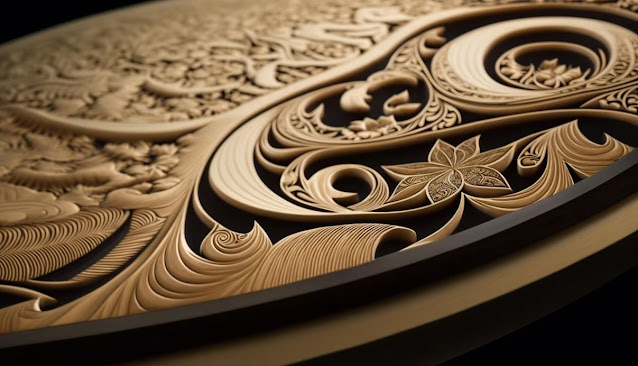In the world of art and craftsmanship, there exists a centuries-old technique that continues to captivate and inspire with its timeless beauty and intricate precision—Inlay Artistry. This age-old craft has left its indelible mark on history, adorning palaces, temples, and exquisite furniture with its breathtaking designs. In this journey through the world of Inlay Artistry, we will delve into its rich history, the meticulous techniques involved, and its enduring relevance in the modern era.
A Glimpse into History
Inlay art, also known as marquetry or intarsia, has a heritage that stretches back thousands of years. Its roots can be traced to ancient civilizations like Egypt and Mesopotamia, where artisans adorned furniture and tombs with intricate inlay designs. However, it was during the Renaissance period in Europe that inlay artistry truly flourished. Italian craftsmen, in particular, elevated the craft to new heights, creating awe-inspiring pieces that became symbols of wealth and luxury.
Materials of Distinction
At the heart of inlay artistry lies the careful selection of materials. Artisans utilize a variety of elements to create their masterpieces, with some of the most notable materials being:
1. Wood: Different types of wood, each with its unique color and grain pattern, are meticulously crafted and fitted together to form intricate designs.
2. Stone: Precious and semi-precious stones like marble, mother-of-pearl, and lapis lazuli are finely shaped to add shimmering details and contrast.
3. Metal: Metals like brass and copper are used to create elegant accents and highlights within the artwork.
4. Shell: The iridescent qualities of shells like abalone and black lip provide an enchanting luster to inlay designs.
The Art of Precision
Inlay artistry is defined by its meticulous attention to detail. Artisans employ a series of complex techniques to ensure precision and perfection in their work. Some of these techniques include:
1. Marquetry: This method involves cutting and fitting pieces of wood or other materials into intricate patterns and designs. The pieces are then glued onto a wooden surface to create a composite image.
2. Intarsia: Intarsia takes marquetry a step further by using different materials to create three-dimensional effects within the design. This technique adds depth and realism to the artwork.
3. Engraving: Artisans may use engraving tools to carve fine lines and details into the base material, enhancing the overall texture and depth of the piece.
4. Inlaying Stones: Precious stones are carefully cut and shaped to fit precisely into cavities created in the wooden or metal base. This delicate process requires exceptional skill.
Enduring Beauty and Modern Applications
Inlay artistry, once reserved for the grandest of palaces and elite clientele, has found its place in the modern world. Today, it graces a wide range of objects and spaces, from exquisite furniture to decorative home accents. The enduring appeal of inlay art lies in its ability to seamlessly blend traditional craftsmanship with contemporary design sensibilities.
Furniture: Inlay techniques breathe life into wooden furniture, transforming plain surfaces into works of art. Coffee tables, cabinets, and dressers adorned with inlay designs are highly sought after by collectors and interior designers alike.
Home Decor: Inlay artistry extends to home decor items such as mirrors, trays, and decorative boxes, adding a touch of opulence and sophistication to living spaces.
Architectural Elements: Inlay art can be found in architectural elements like flooring, walls, and ceilings, where it infuses spaces with a sense of grandeur and elegance.
Preserving a Cherished Tradition
As we celebrate the beauty and craftsmanship of inlay artistry, it's essential to recognize the artisans and craftsmen who keep this ancient tradition alive. Their dedication to preserving and evolving this art form ensures that future generations will continue to be mesmerized by the timeless allure of inlay designs.
In conclusion, inlay artistry stands as a testament to the enduring power of human creativity and craftsmanship. Its rich history, meticulous techniques, and modern applications make it a cherished form of artistic expression that continues to inspire and enchant. Whether in palaces, museums, or our own homes, inlay artistry unveils the timeless craftsmanship that transcends eras and captivates the human spirit.
FAQs
Q1: What are the materials commonly used in inlay artistry?
A1: Inlay artisans often work with wood, stone (such as marble and mother-of-pearl), metal, and shells like abalone to create their masterpieces.
Q2: Is inlay artistry still relevant in contemporary design?
A2: Absolutely! Inlay artistry seamlessly blends traditional craftsmanship with modern design sensibilities, making it highly relevant in today's interior decor and architectural projects.
Q3: Where can I find authentic inlay art pieces?
A3: Authentic inlay art pieces can be found in reputable galleries, antique shops, and from skilled artisans who specialize in custom creations.
Conclusion
Inlay artistry, with its rich history and enduring beauty, continues to captivate and inspire. Whether you're a connoisseur of fine craftsmanship or simply someone who appreciates the exquisite, inlay art has a timeless allure that transcends eras and leaves an indelible mark on the world of art and design.


Comments
Post a Comment